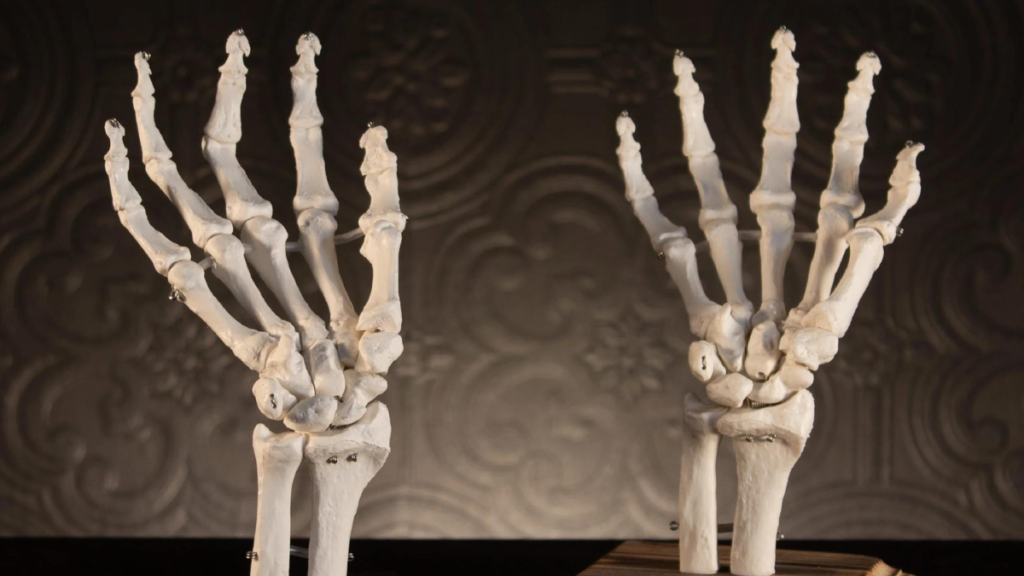The human skeleton hand, a marvel of engineering and structure, has long fascinated humans. Comprising 27 bones, it is a dynamic framework that supports daily activities. The hand’s intricate structure, often associated with mortality, has been a recurring motif in art across cultures and centuries. During the Renaissance, artists like Leonardo da Vinci and Michelangelo studied the human body, focusing on the skeleton hand’s complex network of bones.
The hand’s mobility and functionalities are a testament to the marvels of human anatomy. The arrangement of bones, joints, and ligaments allows for a range of movements and functionalities, from delicate and precise motions to robust and forceful actions. The hand’s versatility is a testament to the sophistication of human anatomy.
The skeleton hand transcends its biological function, manifesting in various cultural contexts, including religious symbolism and contemporary subcultures. In religious celebrations, the hand is depicted engaging in everyday activities, emphasizing the belief that death is a natural part of the human experience. In popular culture, the skeleton hand is portrayed in tattoos and graphic designs, embracing themes of rebellion, mortality, and the macabre.
The Intricacies of Structure
At the core of the skeleton hand’s allure lies its intricate structure. Comprising 27 bones, the hand is a symphony of interconnected elements, each playing a crucial role in enabling the myriad movements we often take for granted. The metacarpals, phalanges, and carpals collaborate seamlessly, creating a dynamic framework that supports our daily activities.
An Artistic Tapestry: Skeleton Hands in Visual Arts
Art has perpetually found inspiration in the human form, and the skeleton hand is no exception. From the haunting depictions in medieval religious art to the meticulous anatomical studies of the Renaissance, artists have sought to capture the essence of the hand’s structure and symbolism.
A. Symbolism in Art
The skeleton hand, often associated with mortality, has been a recurring motif in art across cultures and centuries. In Vanitas paintings, a genre prevalent in the 16th and 17th centuries, the hand frequently makes an appearance, serving as a potent reminder of life’s transience. Its bony fingers clutching at symbols of wealth and pleasure emphasize the inevitability of death.
B. Anatomical Precision in Renaissance Art
During the Renaissance, artists such as Leonardo da Vinci and Michelangelo delved into detailed anatomical studies, striving to understand and accurately represent the human body. The skeleton hand, with its complex network of bones, became a focal point in these studies, contributing to a deeper comprehension of anatomy and influencing the portrayal of hands in art for centuries to come.
The Marvel of Mobility: Functionality in Anatomy
Beyond its role as a muse for artists, the skeleton hand is a testament to the marvels of human anatomy. The intricate arrangement of bones, joints, and ligaments allows for a remarkable range of movements and functionalities, from delicate and precise motions to robust and forceful actions.
A. Precision in Grasping and Manipulation
The arrangement of phalanges and joints in the hand facilitates a high degree of precision in grasping and manipulating objects. This evolutionary adaptation has played a pivotal role in the development of human civilization, enabling the creation of tools, art, and intricate craftsmanship.
B. The Dance of Muscles and Bones
As the muscles contract and relax, guided by the intricate choreography of tendons, the skeleton hand performs a symphony of movements. From the graceful movements of a pianist’s fingers to the strength exhibited in a climber’s grip, the hand’s versatility is a testament to the sophistication of human anatomy.
Cultural Significance: Skeleton Hands Across Time and Space
The skeleton hand transcends the realm of anatomy and art, manifesting in various cultural contexts. From religious symbolism to contemporary subcultures, its presence echoes through time, assuming diverse meanings that reflect societal beliefs and values.
A. Religious Symbolism
In many cultures, the skeleton hand is intertwined with religious symbolism, often representing the fleeting nature of life and the inevitability of death. In Mexican Dia de los Muertos celebrations, skeletal hands are depicted engaging in everyday activities, emphasizing the belief that death is not to be feared but embraced as a natural part of the human experience.
B. Contemporary Imagery in Popular Culture
The skeleton hand continues to captivate contemporary imaginations, finding a place in popular culture and subcultures. From tattoos to graphic designs, its stark and evocative silhouette serves as a powerful symbol, embracing themes of rebellion, mortality, and the macabre.
Conclusion: A Timeless Symbol of Life’s Fragility and Beauty
In conclusion, the skeleton hand transcends its biological function, emerging as a powerful symbol in art, anatomy, and cultural contexts. Its intricate structure, immortalized by artists and studied by anatomists, serves as a reminder of the beauty and fragility inherent in the human experience. As we unravel the mysteries of the skeleton hand, we uncover not just the secrets of anatomy but also the profound connections between art, culture, and the human condition.







